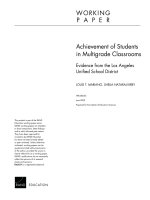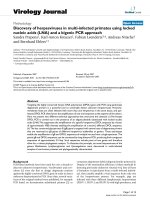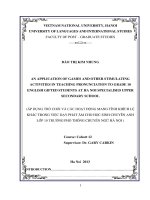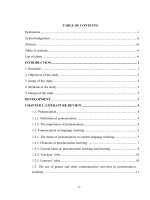Graphical modeling of asymmetric games and value of information in multi agent decision systems
Bạn đang xem bản rút gọn của tài liệu. Xem và tải ngay bản đầy đủ của tài liệu tại đây (672.72 KB, 149 trang )
GRAPHICAL MODELING OF ASYMMETRIC
GAMES AND VALUE OF INFORMATION IN MULTIAGENT DECISION SYSTEMS
WANG XIAOYING
NATIONAL UNIVERSITY OF SINGAPORE
2007
GRAPHICAL MODELING OF ASYMMETRIC
GAMES AND VALUE OF INFORMATION IN MULTIAGENT DECISION SYSTEMS
WANG XIAOYING
(B.Mgt., Zhejiang University)
A THESIS SUBMITTED
FOR THE DEGREE OF MASTER OF ENGINEERING
DEPARTMENT OF INDUSTRIAL & SYSTEMS
ENGINEERING
NATIONAL UNIVERSITY OF SINGAPORE
2007
ACKNOWLEDGEMENTS
I would like to express my thanks and appreciations to Professor Poh Kim Leng and
Professor Leong Tze Yun.
My supervisor, Professor Poh Kim Leng, provided much guidance, support,
encouragement and invaluable advices during the entire process of my research. He
introduced me the interesting research area of decision analysis and discussed with me
the ideas in this area. Professor Leong Tze Yun provided insightful suggestions to my
topic during our group seminars.
Dr. Zeng Yifeng guided me in the research area of decision analysis and discussed with
me on this research topic.
All the past and present students, researchers in the Department of Industrial & Systems
Engineering and Bio-medical Decision Engineering (BiDE), serve as a constant source of
advices and intellectual support.
To my parents, I owe the greatest debt of gratitude for their constant love, confidence and
encouragement on me.
Special thanks to my boyfriend Zhou Mi for his support on me during the entire course of
writing this thesis and his help with the revision, my labmate Han Yongbin for helping
me with the format and my dearest friend Wang Yuan, Guo Lei for their warm
encouragements.
I
Table of Contents
1
2
Introduction.................................................................................. 1
1.1
Background and Motivation ................................................................... 2
1.2
Multi-agent Decision Problems .............................................................. 4
1.3
Objectives and Methodologies................................................................ 5
1.4
Contributions........................................................................................... 5
1.5
Overview of the Thesis ........................................................................... 7
Literature Review ........................................................................ 9
2.1
Graphical Models of Representing Single Agent Decision Problems .... 9
2.1.1
Bayesian Networks ......................................................................... 9
2.1.2
Influence Diagrams....................................................................... 13
2.1.3
Asymmetric Problems in Single Agent Decision Systems ........... 16
2.2
Multi-agent Decision Systems .............................................................. 19
2.3
Graphical Models of Representing Multi-agent Decision Problems .... 22
2.3.1
Extensive Form Game Trees......................................................... 22
2.3.2
Multi-agent Influence Diagrams ................................................... 23
2.4
3
Value of Information (VOI) in Decision Systems ................................ 28
2.4.1
Value of Information in Single Agent Decision Systems............. 28
2.4.2
Computation of EVPI ................................................................... 29
Asymmetric
Multi-agent
Influence
Diagrams:
Model
Representation .................................................................................. 35
3.1
Introduction........................................................................................... 35
3.2
Asymmetric Multi-agent Decision Problems........................................ 38
II
3.2.1
Different Branches of Tree Containing Different Number of Nodes
……………………………………………………………………38
3.2.2
Different Branches of Tree Involves Different Agents................. 41
3.2.3
Player’s Choices are Different in Different Branches of Tree...... 44
3.2.4
Different Branches of Tree Associated with Different Decision
Sequences...................................................................................................... 45
3.3
4
Asymmetric Multi-agent Influence Diagrams ...................................... 46
Asymmetric
Multi-agent
Influence
Diagrams:
Model
Evaluation.......................................................................................... 56
5
4.1
Introduction........................................................................................... 56
4.2
Relevance Graph and S-Reachability in AMAID................................. 58
4.3
Solution for AMAID............................................................................. 61
4.3.1
AMAID With Acyclic Relevance Graph...................................... 61
4.3.2
AMAID With Cyclic Relevance Graph........................................ 65
4.4
A Numerical Example........................................................................... 67
4.5
Discussions ........................................................................................... 69
Value of Information in Multi-agent Decision Systems ......... 71
Incorporating MAID into VOI Computation........................................ 71
5.1
5.1.1
N is Observed by Agent A Prior to Da .......................................... 74
5.1.2
N is Observed by Agent B Prior to Db .......................................... 77
5.1.3
N is Observed by Both Agents A and B ........................................ 78
5.2
VOI in Multi-agent Systems – Some Discussions and Definitions ...... 80
5.3
Numerical Examples............................................................................. 88
5.4
Value of Information for the Intervened Variables in Multi-agent
Decision Systems .............................................................................................. 95
5.4.1
Problem ......................................................................................... 95
III
6
7
5.4.2
Canonical Form of MAIDs ........................................................... 98
5.4.3
Independence Assumption in Canonical Form of MAID ........... 101
Qualitative Analysis of VOI in Multi-agent Systems ........... 103
6.1
Introduction......................................................................................... 103
6.2
Value of Nature Information in Multi-agent Decision Systems ......... 105
6.3
Value of Moving Information in Multi-agent Decision Systems ....... 114
6.4
Examples............................................................................................. 117
Conclusion and Future Work ................................................. 120
7.1
Conclusion .......................................................................................... 120
7.2
Future Work ........................................................................................ 123
Reference ......................................................................................... 124
IV
Summary
Multi-agent decision problem under uncertainty is complicated since it involves a
lot of interacting agents. The Pareto optimal set does not remain to be the Nash
equilibria in multi-agent decision systems. Many graphical models have been
proposed to represent the interactive decisions and actions among agents. Multiagent Influence Diagrams (MAIDs) are one of them, which explicitly reveal the
dependence relationship between chance nodes and decision nodes compared to
extensive form trees. However, when representing an asymmetric problem in
multi-agent systems, MAIDs do not turn out to be more concise than extensive
form trees.
In this work, a new graphical model called Asymmetric Multi-agent Influence
Diagrams (AMAIDs) is proposed to represent asymmetric decision problems in
multi-agent decision systems. This framework extends MAIDs to represent
asymmetric problems more compactly while not losing the advantages of MAIDs.
An evaluation algorithm adapted from the algorithm of solving MAIDs is used to
solve AMAID model.
V
Value of information (VOI) analysis has been an important tool for sensitivity
analysis in single agent systems. However, little research has been done on VOI
in the multi-agent decision systems. Works on games have discussed value of
information based on game theory. This thesis opens the discussion of VOI based
on the graphical representation of multi-agent decision problems and tries to
unravel the properties of VOI from the structure of the graphical models. Results
turn out that information value could be less than zero in multi-agent decision
systems because of the interactions among agents. Therefore, properties of VOI
become much more complex in multi-agent decision systems than in single agent
systems. Two types of information value in multi-agent decision systems are
discussed, namely Nature Information and Moving Information. Conditional
independencies and s-reachability are utilized to reveal the qualitative relevance
of the variables.
VOI analysis can be applied to many practical areas to analyze the agents’
behaviors, including when to hide information or release information so as to
maximize the agent’s own utility. Therefore, discussions in this thesis will turn
out to be of interest to both researchers and practitioners.
VI
List of Figures
Figure 2.1 An example of BN............................................................................... 10
Figure 2.2 A simple influence diagram................................................................. 15
Figure 2.3 An example of SID.............................................................................. 17
Figure 2.4 Game tree of a market entry problem.................................................. 23
Figure 2.5 A MAID............................................................................................... 26
Figure 2.6 A relevance graph of Figure 2.5 .......................................................... 27
Figure 3.1 Naive representations of Centipede Game .......................................... 40
Figure 3.2 MAID representation of Killer Game.................................................. 43
Figure 3.3 MAID representation of Take Away Game ........................................ 45
Figure 3.4 MAID representation of the War Game .............................................. 46
Figure 3.5 An AMAID representation of the Centipede Game ............................ 48
Figure 3.6 The cycle model .................................................................................. 50
Figure 3.7 Reduced MAID by initiating D11 ........................................................ 53
Figure 4.1 De-contextualize contextual utility node............................................. 60
Figure 4.2 Constructing the relevance graph of the AMAID ............................... 61
Figure 4.3 Reduced AMAID M [ D2100
A] of the Centipede Game.................... 65
Figure 4.4 The relevance graph of the Killer Game ............................................. 67
Figure 4.5 Numerical example of the Centipede Game........................................ 68
Figure 4.6 Reduced AMAID M [ D2100
A] ........................................................ 69
Figure 5.1 A MAID without information to any agent......................................... 74
Figure 5.2 A MAID with agent A knowing the information................................. 77
Figure 5.3 A MAID with agent B knowing the information................................. 78
Figure 5.4 A MAID with both agents A and B knowing the information............. 80
VII
Figure 5.5 The MAIDs, relevance graphs and game tree of manufacturer example
............................................................................................................................... 90
Figure 5.6 An ID of decision-intervened variables in single agent decision
systems.................................................................................................................. 97
Figure 5.7 MAID of decision-intervened variables in Multi-agent decision system
............................................................................................................................... 98
Figure 5.8 Canonical Form of MAID ................................................................. 100
Figure 5.9 Convert MAID to canonical form. .................................................... 101
Figure 6.1 An example of VOI properties .......................................................... 117
Figure 6.2 New model M D 2 |N , after N3 is observed by Da 2 ................................ 118
a
3
VIII
List of Tables
Table 5.1 Utility matrices of the two manufacturers ............................................ 88
Table 5.2 Expected utilities of the four situations ................................................ 91
Table 5.3 Utility matrices of the two manufacturers-Example 2.......................... 92
Table 5.4 Expected utilities of the four situations-Example 2.............................. 92
IX
[This page intentionally left blank]
X
1 Introduction
Decision making in our daily life is hard because the decision situations are
complex and uncertain. Decision analysis provides decision makers a kind of
tools for thinking systematically about hard and complex decision problems to
achieve clarity of actions (Clemen 1996). If there is more than one person
involved in the decision, the complexity of decision making is raised. Such
decision problems are often modeled as multi-agent decision problems in which a
number of agents cooperate, coordinate and negotiate with each other to achieve
the best outcome in uncertain environments. In multi-agent systems, agents will
be representing or acting on behalf of users and owners with very different goals
and motivations in most cases. Therefore, the same problems under single agent
systems and multi-agent systems would sometimes generate quite different
outcomes and properties.
The theories in multi-agent decision systems provide a foundation of this thesis.
In this chapter, we will introduce the motivation of writing this thesis and define
the basic problem addressed in this thesis. The last section of this chapter gives an
1
Chapter 1: Introduction
overview of the remainder of the thesis.
1.1 Background and Motivation
Making a good decision in a multi-agent system is complicated since both the
nature of decision scenarios and the attributes of multiple agents have to be
considered. However, such situation is always unavoidable since people are
always involved into a large social network. Therefore, analyzing, representing
and solving decision problems under such circumstances become meaningful.
Many graphical models in single agent areas have been extended to model and
solve decision problems in multi-agent areas, such as Multi-agent Influence
Diagrams (MAIDs). MAIDs extend Influence Diagrams (IDs) to model the
relevance between chance nodes and decision nodes in multi-agent decision
systems. They successfully reveal the dependency relationships among variables,
of which extensive game trees lack. However, in representing asymmetric
decision problems, the specification load of a MAID is often worse than an
extensive game tree. Hence, a new graphical model is needed for representing and
solving these asymmetric decision problems. Examples in this thesis will show
the practical value of our proposed models.
2
Chapter 1: Introduction
On the other hand, when agents make decisions in a decision system, information
puts a direct influence on the quality of the decisions(Howard 1966). Agents can
be better off or worse off by knowing a piece of information and the time to know
this information. Information value plays an important role in the decision making
process of agents. For example, in Prisoner’s Dilemma game, one prisoner can get
higher payoff if he/she knows the decision of another prisoner. Since information
gathering is usually associated with a cost, computing how much value of this
information will add to the total benefit has been a focus for agents.
Until now, researches on value of information (VOI) have been confined in the
single agent decision systems. Information value involving multiple agents has
been discussed in games. They use mathematical inductions and theorems to
discuss the influence of information structure and agents’ payoff functions on the
sign of information value. Many properties of VOI in multi-agent decision
systems have not been revealed yet. Different kinds of information values have
not been categorized. Recently, researches in decision analysis have developed
graphical probabilistic representation to model decision problems. This work
opens the discussion of VOI based on the graphical models.
3
Chapter 1: Introduction
1.2 Multi-agent Decision Problems
This work is based on multi-agent decision systems, which have different
characteristics from single agent decision systems. Firstly, a multi-agent decision
problem involves a group of agents, while a single agent decision problem only
involves one agent. Secondly, those agents have intervened actions or decisions
because their payoff functions are influenced by other agents’ actions. Thirdly,
each agent’s decision may be observed or not observed by other agents, while a
decision maker always observes its previous decisions in a single agent decision
system. Fourthly, agents can cooperate or compete with each other; Fifthly, agents
have their individual objectives although they may seek a cooperative solution.
Every agent is selfish and seeks to maximize its own utility, without considering
others’ utilities. They cooperate with each other by sharing information. Because
of these differences, decision problems in multi-agent decision systems and single
agent decision systems are quite different. In multi-agent decision models,
decision interaction among agents is an interesting and essential problem. The
output of a multi-agent decision model may not always be a Pareto optimality set,
but the Nash equilibria. However, in single agent systems, the output of the model
is always a Pareto optimality set.
4
Chapter 1: Introduction
1.3 Objectives and Methodologies
The goal of this thesis is to establish a new graphical model for representing and
solving asymmetric problems in multi-agent decision systems, as well as
discussing value of information in multi-agent decision systems. To achieve this
goal, we carry out the stages as follows:
First of all, we build a new flexible framework. The main advantage of this
decision-theoretic framework lies in its capability for representing asymmetric
decision problems in multi-agent decision systems. It encodes the asymmetries
concisely and naturally while maintaining the advantages of MAID. Therefore, it
can be utilized to model complex asymmetric problems in multi-agent decision
systems.
The evaluation algorithm of MAIDs is then extended to solve this model based on
the strategic relevance of agents.
1.4 Contributions
The major contributions of this work are as follows:
Firstly, we propose a new graphical model to represent asymmetric multi-agent
5
Chapter 1: Introduction
decision problems. Four kinds of asymmetric multi-agent decision problems are
discussed. This framework is argued for its ability to represent these kinds of
asymmetric problems concisely and naturally compared to the existing models. It
enriches the graphical languages for modeling multiple agent actions and
interactions.
Secondly, the evaluation algorithm is adopted to solve the graphical model.
Extending from the algorithm of solving MAIDs, this algorithm is shown to be
effective and efficient in solving this model.
Thirdly, we open the door of discussing value of information based on the
graphical model in multi-agent decision systems. We define some important and
basic concepts of VOI in multi-agent decision systems. Ways of VOI computation
using existing MAIDs are studied.
Fourthly, some important qualitative properties of VOI are revealed and verified
in multi-agent systems, which also facilitate fast VOI identification in the real
world.
Knowledge of VOI of both chance nodes and decision nodes based on a graphical
model can guide decision analyst and automated decision systems in gathering
6
Chapter 1: Introduction
information by weighing the importance and information relevance of each node.
The methods described in this work will serve this purpose well.
1.5 Overview of the Thesis
This chapter has given some basic ideas in decision analysis, introduced the
objective and motivation of this thesis and described the methodologies used and
the contributions in a broad way.
The rest of this thesis is organized as follows:
Chapter 2 introduces related work involving graphical models and evaluation
methods both in single agent decision system and multi-agent decision system.
Most of current work on VOI computation in single agent decision systems is also
covered.
Chapter 3 proposes a graphical multi-agent decision model to represent
asymmetric multi-agent decision problems. Four main types of asymmetric
problems are discussed and the characteristics of this new model are highlighted.
Chapter 4 presents the algorithm for solving this new decision model. The
7
Chapter 1: Introduction
complexity problem is discussed in this section as well.
Chapter 5 defines VOI in multi-agent decision systems illustrated by a basic
model of multi-agent decision systems. Different kinds of information value are
categorized. A numerical example is used to illustrate some important properties
of VOI in multi-agent decision systems.
Chapter 6 verifies some qualitative properties of VOI in multi-agent decision
systems based on the graphical model.
Chapter 7 summarizes this thesis by discussing the contributions and limitations
of the work. It also suggests some possible directions for future work.
8
2 Literature Review
This chapter briefly surveys some related work: graphical models for representing
single agent decision problems, graphical models for representing multi-agent
decision problems, multi-agent decision systems, and value of information in
single agent decision systems. This survey provides a background for a more
detailed analysis in the following chapters and serves as a basis to the extension of
these existing methodologies.
2.1 Graphical Models for Representing Single Agent Decision
Problems
2.1.1 Bayesian Networks
Bayesian networks are the fundamental graphical modeling language in
probabilistic modeling and reasoning. A Bayesian network (Pearl 1998;
Neapolitan 1990; Jensen 1996; Castillo et al. 1997) is a triplet (X, A, P) in which
X is the set of nodes in the graph, A is the set of directed arcs between the nodes
and P is the joint probability distribution over the set of uncertain variables. Each
9
Chapter 2: Literature Review
node x ∈ X is called a chance node in a BN which has an associated conditional
probability distribution P( x π ( x)) ( π ( x) denotes all x ’s parents) associated. The
arc between nodes indicates the relevance, probabilistic or statistical correlation
relationship between the variables. P = ∏ p ( x | π ( x )) defines a multiplicative
x∈ X
factorization function of the conditional probability of individual variables. An
example of BN is shown in Figure 2.1.
a
c
b
d
e
f
Figure 2.1 An example of BN
This BN contains six nodes { a, b, c, d , e, f }. Each node in the BN has one
conditional probability given its parents. Take node d for example, π (d ) ={ a, b }
and the conditional probability associated with it is p (d | (a, b)) . BN is an acyclic
directed graph (DAG). The joint probability distribution of a BN is defined by its
DAG structure and the conditional probabilities associated with each variable.
Therefore, in Figure 2.1, the joint probability distribution can be represented as:
P (a, b, c, d , e, f ) = p (a ) p(e) p(c | a) p ( f | d ) p(b | e) p( d | ( a, b)) .
An important property of BNs is d-separation. The notion of d-separation can be
10
Chapter 2: Literature Review
used to identify conditional independence of any two distinct nodes in the
network given any third node. The definition (Jensen, 1996 & 2001) is given
below:
Definition 2.1 Let G be a directed acyclic graph and X, Y, Z are the three disjoint
subsets of the nodes in G. Then X and Y are said to be d-separated by Z if for
every chain from any node in X to any node in Y, the following conditions are
satisfied:
1. If an intermediate node A on the chain is in a converging connection(headto-head), neither A nor its descendants are in Z;
2. If an intermediate node A on the chain is in a serial (head-to-tail) or
diverging (tail-to-tail) connection, and A is in Z.
Each chain satisfying the above conditions is called blocked, otherwise it is active.
In this example, nodes d and e are d-separated given node b.
Probabilistic inference in BNs has been proven to be NP-hard (Cooper 1990). In
the last 20 years, various inference algorithms have been developed, including
exact and approximate methods. The exact methods include Kim and Pearl’s
message passing algorithm (Pearl 1988; Neapolitan 1990; Russell & Norvig 2003),
junction tree method (Lauritzen & Spiegelhalter 1988; Jensen et al. 1990; Shafer
11
Chapter 2: Literature Review
1996; Madsen & Jensen 1998), cutest conditioning method (Pearl 1988;
Suermondt & Cooper 1991), direct factoring method (Li & Ambrosio 1994),
variable elimination method (Dechter 1996) etc.
The approximate methods include logic sampling method (Henrion 1988),
likelihood weighting (Fung & Chang 1989; Shachter & Peot 1992), Gibbs
sampling (Jensen 2001), self-importance sampling and heuristic-importance
sampling (Shachter 1989), adaptive importance sampling (Cheng & Druzdzel
2000) and backward sampling (Fung & Favero 1994). A number of other
approximate inference methods have also been proposed. Since the exact
inference methods usually require a lot of computational costs, approximate
algorithms are usually used for large networks. However, Dagum and Luby (1993)
showed that the approximate inference methods are also NP-hard within an
arbitrary tolerance.
Many extensions have been made to BNs in order to represent and solve some
problems under special conditions. For example, the dynamic Bayesian networks
(DBNs, Nicholson 1992; Nicholson & Brady 1992; Russell & Norvig 2003),
probabilistic temporal networks (Dean & Kanazawa 1989; Dean & Wellman
1991), dynamic causal probabilistic networks (Kjaerulff 1997) and modifiable
temporal belief networks (MTBNs, Aliferis et al. 1995, 1997) to model time12









